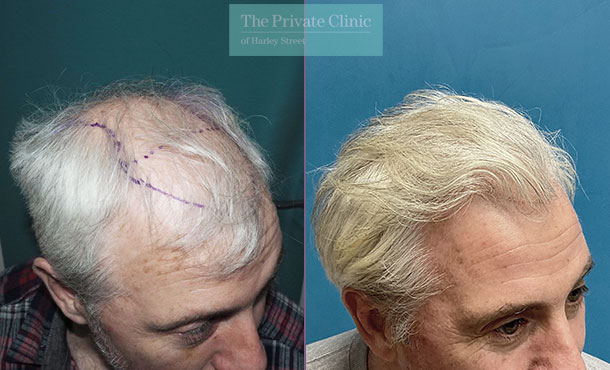
Hair loss can be a distressing experience for many people, regardless of age. As people get older, they may notice their hair turning grey or white. But what happens if they also experience hair loss? Can a hair transplant be done for grey or white hair? In this article, we will explore the possibilities, myths, and facts about hair transplants for people with grey or white hair.
Understanding Hair Transplant:-
A hair transplant is a surgical procedure that involves moving hair follicles from one part of the scalp (called the donor area) to a bald or thinning area (called the recipient area). This method is commonly used to restore hair growth in people suffering from baldness or hair thinning.
There are two main types of hair transplant procedures:
Follicular Unit Transplantation (FUT): A strip of skin with hair follicles is taken from the donor area, and individual hair follicles are implanted into the recipient area.
Follicular Unit Extraction (FUE): Individual hair follicles are extracted one by one from the donor area and implanted into the recipient area.
Both methods are effective, but the choice depends on the patient’s needs and the surgeon’s recommendation.
Can Grey or White Hair Be Transplanted?
Yes, grey or white hair can be transplanted just like pigmented hair. Hair color is determined by melanin, but the follicle structure remains the same, making transplantation effective. The success of the procedure depends on the donor area’s hair density and quality, not its color. FUE (Follicular Unit Extraction) and FUT (Follicular Unit Transplantation) work for grey or white hair, ensuring natural growth. However, surgeons must carefully identify and extract follicles, as grey hair may blend with the scalp. Post-transplant, the hair continues to grow naturally, maintaining its grey or white shade without darkening or changing color.
How Does Hair Transplant Work for Grey or White Hair?
Follicle Extraction: The surgeon extracts healthy hair follicles from the donor area, usually the back or sides of the scalp.
Graft Preparation: The extracted follicles are prepared for implantation.
Implantation: The surgeon implants the follicles into the recipient area.
Healing and Growth: After a few months, the transplanted hair starts growing naturally.
Since hair color is determined by pigment cells (melanocytes) in the hair follicle, transplanted grey or white hair will continue to grow as grey or white hair.
Factors Affecting Hair Transplant Success for Grey or White Hair:-
Several factors affect the success of hair transplants for grey or white hair. The quality and density of the donor area are crucial, as thicker follicles provide better coverage. Surgeon expertise is essential since grey hair blends with the scalp, making extraction and implantation more challenging. The follicle’s health, not its color, determines transplant success. Blood circulation, scalp health, and proper post-care influence growth. Age-related slower healing may require extra attention. Using FUE or FUT techniques, a skilled surgeon ensures natural-looking results. Healthy lifestyle choices, proper nutrition, and avoiding harsh treatments also improve long-term hair growth outcomes.
While hair transplants for grey or white hair are possible, several factors can influence the results:
1. Hair Follicle Health
The quality of the donor hair is crucial. If the follicles are healthy and strong, they will produce strong hair even after transplantation.
2. Scalp Condition
A healthy scalp provides a better environment for hair growth. Conditions like scalp infections or excessive dryness can affect the success of the transplant.
3. Surgeon’s Expertise
A skilled and experienced surgeon can ensure a successful transplant by carefully extracting and implanting hair follicles.
4. Post-Transplant Care
Proper aftercare, including a healthy diet, avoiding excessive sun exposure, and following the surgeon’s instructions, is essential for a successful hair transplant.
Common Myths About Hair Transplant for Grey or White Hair:
There are several myths about hair transplants for grey or white hair. One common myth is that grey hair cannot be transplanted, but in reality, hair color does not affect follicle viability. Another myth is that transplanted grey hair will turn black, but transplanted hair maintains its natural color. Some believe older individuals are not good candidates, but age is not a barrier if the donor area is healthy. Others think that grey hair grows slower, but its growth rate is the same as pigmented hair. Choosing a skilled surgeon ensures successful results, regardless of hair color.
There are several myths surrounding hair transplants for grey or white hair. Let’s clear up some of the most common ones:
Myth 1: Grey Hair Cannot Be Transplanted
Fact: Grey hair can be transplanted just like any other hair color. The success of the procedure depends on follicle health, not hair color.
Myth 2: Transplanted Grey Hair Will Turn Black
Fact: Transplanted hair retains its original color. If the donor hair is grey or white, it will remain grey or white after the transplant.
Myth 3: Grey Hair is Weaker Than Colored Hair
Fact: Grey hair may appear thinner, but it is just as strong as black or brown hair. Hair strength depends on follicle health, not color.
Myth 4: Hair Transplant is Painful and Risky
Fact: Hair transplant procedures are performed under local anesthesia, making them relatively painless. The risks are minimal when performed by an experienced surgeon.
Who is a Good Candidate for a Grey or White Hair Transplant?
A good candidate for a grey or white hair transplant is someone with sufficient donor hair, regardless of color. Age is not a limiting factor, as long as the person has healthy hair follicles and a stable donor area. Those experiencing pattern baldness (androgenetic alopecia) or hair loss due to injury or scarring can benefit. Candidates should have good scalp health, realistic expectations, and a commitment to post-transplant care. Medical conditions like diabetes or poor circulation may affect healing, so a consultation with a qualified surgeon is essential. With proper care, grey or white transplanted hair grows naturally and permanently.
A hair transplant is suitable for many people, but the best candidates for a grey or white hair transplant are:
Individuals with a good donor area
People with realistic expectations
Those with stable hair loss
Healthy individuals without serious medical conditions
How to Prepare for a Hair Transplant Procedure:-
Preparing for a hair transplant ensures the best results. Stop smoking and alcohol at least two weeks before to improve healing. Avoid blood-thinning medications, aspirin, and anti-inflammatory drugs as advised by your doctor. Stay hydrated and eat a nutrient-rich diet to support recovery. Refrain from haircuts, chemical treatments, or harsh styling before surgery. On the day of the procedure, wear loose, comfortable clothing to avoid disturbing the scalp post-surgery. Follow all pre-op instructions from your surgeon, including washing your scalp with a prescribed shampoo. A healthy scalp, proper planning, and a skilled surgeon contribute to a successful transplant outcome.
If you are considering a hair transplant for grey or white hair, follow these steps:
Consult a Specialist: Meet with a hair transplant surgeon to discuss your needs and expectations.
Stop Smoking and Alcohol Consumption: Smoking and alcohol can slow down healing.
Follow a Healthy Diet: Eat nutrient-rich foods to support hair growth.
Avoid Blood Thinners: Medications like aspirin can increase bleeding during the procedure.
Aftercare Tips for a Successful Hair Transplant:-
Proper aftercare is essential for a successful hair transplant. Avoid touching, scratching, or washing the transplanted area for the first 48 hours. Sleep with your head elevated to reduce swelling. Use only gentle, prescribed shampoos after a few days and avoid hot water or harsh rubbing. Stay away from direct sunlight, heavy exercise, and sweating for at least two weeks. Avoid alcohol and smoking, as they slow healing. Do not pick at scabs; let them fall naturally. Stay hydrated and eat a nutrient-rich diet to support hair growth. Follow your surgeon’s instructions and attend follow-up appointments for optimal results.
To ensure the best results, follow these aftercare tips:
Keep the scalp clean and avoid touching the transplanted area.
Avoid strenuous activities that can cause sweating.
Follow prescribed medications to prevent infection.
Sleep with your head elevated for the first few days.
Avoid direct sunlight and wear a loose-fitting hat if necessary.
Expected Results After a Grey or White Hair Transplant:-
After a grey or white hair transplant, initial shedding occurs within the first few weeks, which is a normal part of the process. New hair starts growing around three to four months, with significant improvement visible by six to nine months. Full results typically take 12–18 months, depending on individual healing and hair growth rates. Transplanted grey or white hair retains its natural color and texture, growing like regular hair. Proper post-care, a healthy lifestyle, and follow-ups enhance success. While results vary, a well-executed transplant provides permanent, natural-looking coverage, restoring confidence in individuals with age-related or genetic hair loss.
Short-Term Results (1-3 Months):
-
Initial shedding of transplanted hair (normal part of the process)
-
New hair follicles start growing
Mid-Term Results (4-6 Months):
-
Noticeable hair growth in the transplanted area
-
Hair starts looking fuller
Long-Term Results (12+ Months):
-
Fully grown, natural-looking hair
-
Improved density and coverage
Conclusion:-
Hair transplants for grey or white hair are not only possible but also highly successful. The color of your hair does not affect the success of the procedure. If you have healthy hair follicles and follow proper aftercare, you can achieve natural-looking, fuller hair regardless of your hair color.
If you are considering a hair transplant, consult with a professional to determine the best treatment for your needs. Whether your hair is black, brown, or grey, a hair transplant can restore your confidence and give you a youthful appearance

